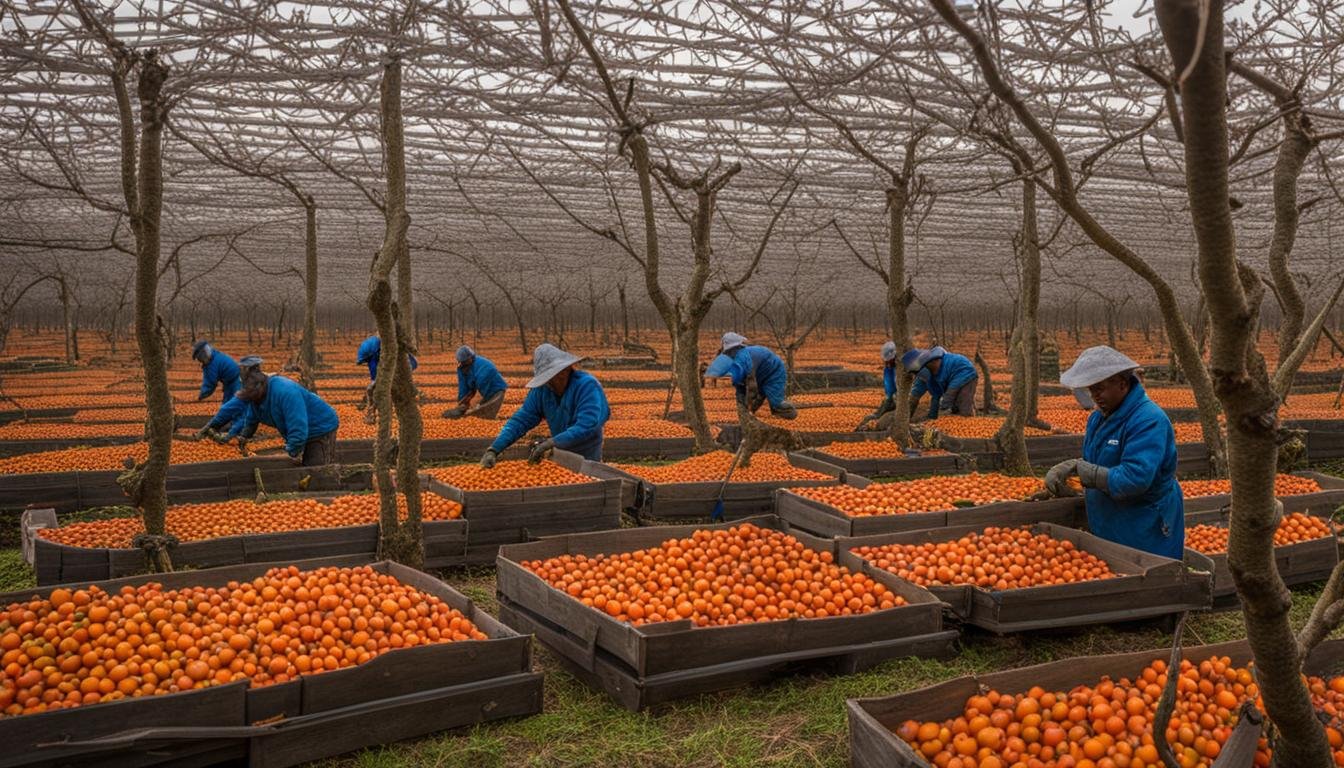Growing persimmons can be a rewarding and profitable endeavor for orchard owners. With their unique flavor and versatility, persimmons are a favorite fruit among many. In this article, I will share valuable tips and techniques to help you optimize your persimmon farming, ensuring a successful harvest and high-quality produce.
Key Takeaways:
- Implementing effective persimmon farming techniques can revolutionize your orchard.
- Understanding the requirements of persimmon trees is crucial for their optimal growth and fruit production.
- Choosing the right persimmon variety for your orchard’s specific conditions is essential.
- Providing optimal growing conditions, managing pests and diseases, and practicing sustainable and organic farming methods are key to success.
- Exploring innovative techniques in persimmon farming can help maximize your orchard’s potential.
Understanding Persimmon Trees and Their Requirements
Persimmon trees require specific conditions to thrive and produce high-quality fruit. By understanding and addressing their needs, you can ensure the success of your persimmon farming endeavors. Here are some essential care practices and best practices for persimmon farming:
The Importance of Sunlight and Soil
Persimmon trees thrive in full sun, so it’s crucial to plant them in an area where they will receive at least 6-8 hours of direct sunlight each day. Additionally, they prefer well-drained soil with a slightly acidic to neutral pH level. Conducting a soil test and making necessary amendments can help create the optimal growing conditions for your persimmon trees.
Watering and Moisture Management
Regular watering is critical for persimmon tree care, particularly during dry periods. Adequate irrigation helps maintain healthy tree growth and promotes fruit production. However, it’s important to avoid overwatering, as excessive moisture can lead to root rot and other issues. Implementing mulching techniques can help conserve soil moisture and reduce weed competition.
Pruning and Training Techniques
Pruning is an essential practice for shaping persimmon trees and promoting their overall health. It helps maintain an open canopy, improves air circulation and sunlight penetration, and removes damaged or diseased branches. Proper training techniques, such as establishing a central leader or modified central leader structure, can also contribute to the tree’s growth and productivity.
Protection from Pests and Diseases
Persimmon trees can be susceptible to various pests and diseases, including aphids, mites, scale insects, bacterial canker, and powdery mildew. Implementing integrated pest management strategies, such as regular monitoring, early detection, and appropriate cultural and chemical controls, can help prevent and manage these issues effectively. Additionally, practicing good sanitation and ensuring proper tree nutrition can enhance the tree’s natural resistance to diseases.
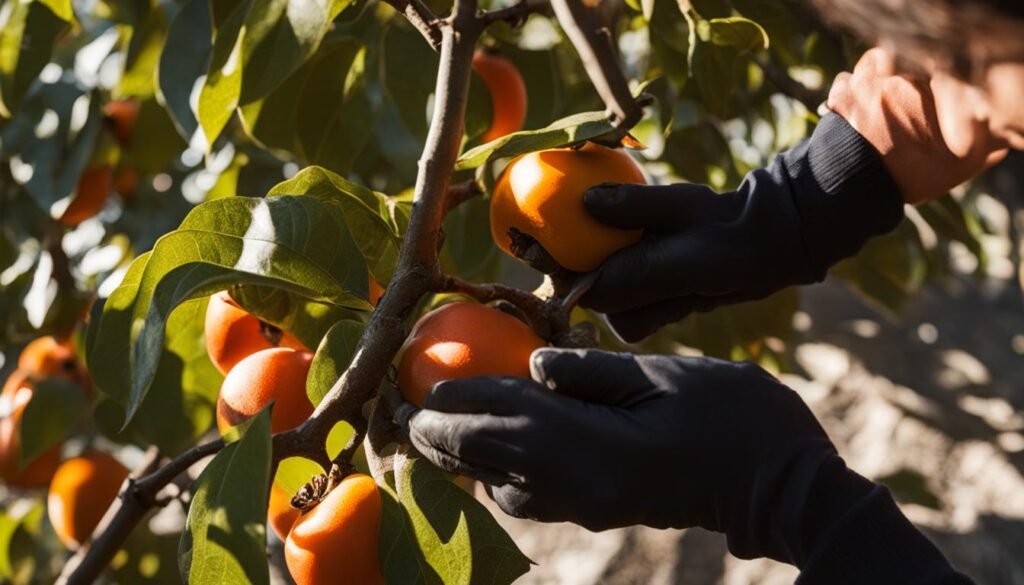
| Common Requirements for Persimmon Trees | Best Practices for Persimmon Farming |
|---|---|
| Full sun exposure | Plant persimmon trees in areas with at least 6-8 hours of direct sunlight per day. |
| Well-drained soil | Ensure proper soil drainage by planting persimmon trees in soil with good water-holding capacity. |
| Slightly acidic to neutral pH | Conduct a soil test and adjust pH levels if necessary to create optimal growing conditions. |
| Regular watering | Provide adequate irrigation, especially during dry periods, to support healthy tree growth. |
| Proper pruning | Prune persimmon trees to maintain an open canopy, promote airflow, and remove damaged branches. |
| Pest and disease management | Implement integrated pest management strategies and practice good sanitation to prevent and manage pests and diseases. |
By understanding and implementing these persimmon tree care practices and best practices for persimmon farming, you can create the optimal conditions for your trees to thrive and produce abundant, high-quality fruit. Stay tuned for the next section, where we will discuss how to select the right persimmon variety for your orchard.
Selecting the Right Variety for Your Orchard
When it comes to growing persimmon trees, selecting the right variety is essential for success, whether you’re planning a commercial orchard or a home garden. Different persimmon varieties have unique growth habits, fruit quality, and adaptability to specific growing conditions. By understanding these factors, you can make informed decisions that will maximize your yield and ensure the best results.
For commercial growers, it’s important to consider market demand when selecting persimmon varieties. Some varieties are highly sought after, while others may have a more limited market. Researching local consumer preferences and consulting with agricultural experts can help you identify the most profitable options for your specific area. Additionally, consider the adaptability of different varieties to your climate and soil conditions to ensure optimal growth and fruit production.
If you’re growing persimmons in a home orchard, you have more flexibility in choosing varieties based on your personal preferences. Some varieties are known for their exceptional flavor, while others may have unique characteristics like early ripening or resistance to pests and diseases. Do some research and consider your desired taste, harvest time, and tree size when making your selection.
Table: Comparison of Select Persimmon Varieties
| Variety | Growth Habit | Fruit Characteristics | Market Demand |
|---|---|---|---|
| Fuyu | Upright and spreading | Non-astringent, crisp, and sweet | High |
| Hachiya | Vigorous and spreading | Astringent, soft when fully ripe | Moderate |
| Gosho | Compact and columnar | Non-astringent, firm texture | Low |
| Nightingale | Small and compact | Non-astringent, rich and complex flavor | Niche |
Consider the information provided in the table above as a starting point for your research, but make sure to consult local nurseries and agricultural extension offices for more specific recommendations for your region. Experimenting with different varieties and observing their performance in your orchard can also provide valuable insights for future planting decisions. With careful selection and proper care, you’ll be on your way to a successful persimmon orchard.
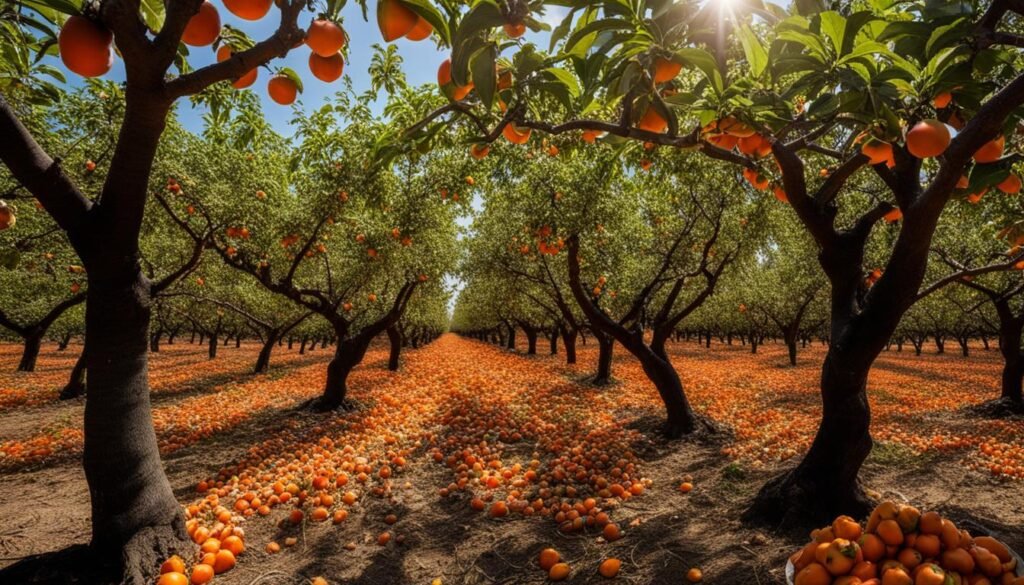
| Common Problems | Symptoms | Solutions |
|---|---|---|
| Bacterial Canker | Dark, sunken lesions on trunk or branches | Prune and destroy infected branches, apply copper-based fungicide |
| Powdery Mildew | White, powdery coating on leaves and fruit | Improve air circulation, apply fungicide |
| Aphids | Small, soft-bodied insects on new growth | Spray with insecticidal soap or neem oil |
| Scale Insects | Small, oval-shaped insects on branches and leaves | Apply horticultural oil or insecticidal soap |
By implementing these tips, you can ensure the health and success of your persimmon trees. Remember to observe your trees closely, address any issues promptly, and adapt your care practices based on your specific growing conditions and tree’s needs.
Managing Pests and Diseases
When it comes to persimmon farming, managing pests and diseases is essential for maintaining the health and productivity of your orchard. By implementing effective pest control strategies, you can prevent infestations and minimize the damage caused by common pests such as aphids, mites, and scale insects. Additionally, proper disease management techniques can help mitigate the risk of bacterial canker, powdery mildew, and root rot.
One approach to pest control is integrated pest management (IPM), which involves a combination of cultural, biological, and chemical control methods. Cultural practices, such as regular pruning and removing diseased plant material, can help reduce pest habitat and prevent the spread of diseases. Biological control involves introducing beneficial insects that prey on pests, helping to naturally control their populations. Chemical control methods, such as selective insecticides or fungicides, should be used judiciously and in accordance with local regulations, prioritizing environmentally friendly options.
Regular monitoring of your orchard is crucial for early detection and intervention. By regularly inspecting your persimmon trees for signs of pests or diseases, you can identify issues before they become widespread and take appropriate action. This may include targeted treatments, adjustments to cultural practices, or seeking advice from agricultural experts.
Implementing effective pest and disease management practices not only helps protect your persimmon trees but also ensures the quality and marketability of your fruit. By staying vigilant and proactive in your approach, you can maintain a healthy orchard and maximize the yield of your persimmons.
| Pest | Disease |
|---|---|
| Aphids | Bacterial canker |
| Mites | Powdery mildew |
| Scale insects | Root rot |
Pruning and Thinning for Optimal Fruit Production
“Pruning and thinning practices play a crucial role in persimmon farming to enhance fruit development and yield.”
Proper pruning and thinning techniques are essential for maximizing fruit production and ensuring the overall health of persimmon trees. Pruning helps shape the tree, improve air circulation, and remove any damaged or diseased branches, while thinning allows for larger, healthier fruits and prevents overcrowding.
When it comes to pruning, it’s important to do so during the dormant season when the tree is not actively growing. This helps minimize stress on the tree and allows for better healing of the pruning wounds. Focus on removing any dead or diseased branches, as well as any branches that are crossing or rubbing against each other. It’s also recommended to prune for shape, particularly if you’re growing persimmons in an orchard or commercial setting.
Thinning, on the other hand, is typically done in the spring when the fruit is still small and green. The goal is to space out the fruit clusters, leaving ample room for each fruit to grow and ripen properly. This process helps prevent the fruits from competing for resources and reduces the risk of fungal infections. Depending on the variety and vigor of the tree, it’s usually advised to thin the fruit clusters to about 4-6 inches apart.
Timing and Techniques
The timing and techniques of pruning and thinning largely depend on the specific variety of persimmon tree and the climatic conditions in your region. Consulting with local agricultural experts or extension services can provide valuable insights and recommendations tailored to your specific needs. Implementing these practices in combination with proper care and maintenance will result in healthier trees and bountiful harvests of delicious persimmons.

| Benefits of Pruning | Benefits of Thinning |
|---|---|
| Shapes the tree for better growth and development | Prevents overcrowding of fruits |
| Improves air circulation and sunlight penetration | Allows for larger, healthier fruits |
| Removes dead, diseased, or damaged branches | Reduces the risk of fungal infections |
By implementing proper pruning and thinning techniques, you can optimize the quality and quantity of persimmon fruits, ensuring a successful harvest. Remember to always follow industry best practices and seek expert advice when needed. With care and attention, your persimmon orchard can thrive and provide you with an abundance of delicious fruits season after season.
Harvesting and Storing Persimmons
When it comes to harvesting persimmons, timing is everything. The fruit should be left on the tree until it has reached its full color and is slightly soft to the touch. Harvesting too early will result in underripe fruit with a less desirable flavor and texture. On the other hand, leaving the fruit on the tree for too long can lead to overripeness and mushiness.
To harvest the persimmons, gently twist or cut the fruit from the tree, being careful not to damage the branches or surrounding fruit. Place the harvested persimmons into shallow containers or baskets to prevent bruising during transport.
Once harvested, persimmons can be stored in a cool, dry place or in the refrigerator to extend their shelf life. It’s important to handle the fruit with care to avoid bruising, as this can accelerate ripening and spoilage. If you have a large harvest, consider using different storage methods such as drying or freezing to preserve the fruit for later use.
| Storage Method | Temperature | Duration |
|---|---|---|
| Refrigeration | 35-45°F (1-7°C) | Up to 2 months |
| Drying | Ambient room temperature | Several months |
| Freezing | 0°F (-18°C) | Up to 12 months |
The storage method you choose will depend on your preferences and the intended use of the persimmons. Refrigeration is a common method and is suitable for short-term storage. Drying is ideal for preserving the fruit’s natural sweetness and can be used in a variety of culinary applications. Freezing is a convenient option if you want to enjoy persimmons throughout the year, as they can be used directly from the freezer in smoothies, desserts, or baked goods.
By understanding the proper harvesting techniques and implementing suitable storage methods, you can ensure that your persimmons remain fresh and delicious for an extended period, allowing you to enjoy the fruits of your labor long after the harvest season.
Marketing and Selling Persimmons
When it comes to persimmon farming, understanding effective marketing and selling strategies is crucial, especially if you are looking to grow persimmons commercially. By implementing the right approach, you can increase the visibility and profitability of your persimmon products while building strong relationships with potential buyers.
One of the first steps in marketing your persimmons is to identify your target market. This will help you tailor your marketing efforts to reach the right audience. Consider whether you want to sell your persimmons directly to consumers, through local grocery stores or farmers’ markets, or to wholesalers who will distribute your fruit to larger markets.
Building relationships with potential buyers is essential for long-term success. Attend industry events, connect with local businesses, and join online forums and social media groups dedicated to farming and agriculture. These platforms provide opportunities to network with potential buyers and learn about the needs and preferences of your target market.
Packaging and labeling your persimmons properly is another important aspect of marketing. Invest in attractive packaging that protects the fruit and showcases its quality. Including your brand logo and essential product information on the packaging will help create a professional image and build trust with consumers.
Table: Comparison of Marketing Channels for Persimmons
| Marketing Channel | Pros | Cons |
|---|---|---|
| Direct-to-Consumer Sales | Higher profit margins, direct interaction with customers, potential for repeat business | Requires additional marketing efforts, limited reach compared to larger markets |
| Local Grocery Stores | Wider customer reach, established customer base, potential for bulk sales | Lower profit margins, limited control over pricing and product placement |
| Farmers’ Markets | Direct interaction with customers, opportunity to educate about persimmons, potential for repeat business | Seasonal availability, limited customer reach, competition from other vendors |
| Wholesalers | Access to larger markets and distribution networks, potential for higher sales volume | Lower profit margins, less control over pricing and branding |
Exploring alternative market channels can also provide additional opportunities to sell your persimmons. Consider joining local co-operatives, partnering with restaurants or specialty food stores, or even offering online sales through your own website or platforms dedicated to selling farm produce.
Remember, marketing and selling persimmons is an ongoing process that requires consistent effort and adaptability. Stay up to date with current trends, consumer preferences, and industry developments to keep your marketing strategies effective and relevant.
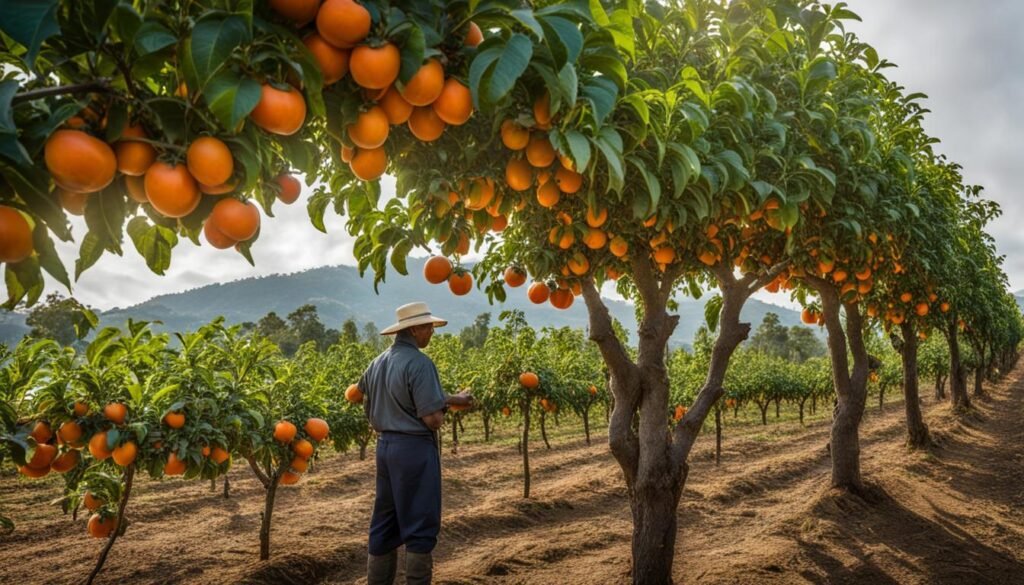
Embracing Sustainable and Organic Practices
When it comes to persimmon farming, incorporating sustainable and organic practices is not only beneficial for the environment but also for the overall quality of your produce. By avoiding the use of synthetic pesticides and fertilizers, you can ensure that your persimmon orchard is free from harmful chemicals, making it a healthier and more sustainable ecosystem.
One of the best practices for persimmon farming is promoting biodiversity within your orchard. By planting a variety of companion plants and creating habitats for beneficial insects and birds, you can naturally control pests and reduce the need for chemical interventions. This approach not only supports the ecological balance but also enhances the overall resilience and productivity of your orchard.
Water conservation is another crucial aspect of sustainable persimmon farming. Implementing techniques such as drip irrigation or installing rainwater harvesting systems can help minimize water waste and ensure that your orchard receives the optimal amount of water. By efficiently managing water resources, you not only reduce your environmental impact but also save on water costs.
Benefits of Embracing Sustainable and Organic Practices:
- Promotes environmental health and biodiversity
- Produces healthier and higher-quality persimmons
- Reduces reliance on synthetic chemicals
- Minimizes water waste and conserves resources
- Meets the growing demand for organic produce
Emphasizing sustainable and organic practices in your persimmon farming not only contributes to the long-term health of your orchard but also meets the growing consumer demand for environmentally friendly produce. By adopting these best practices, you can ensure that your persimmons are not only delicious but also cultivated in a way that respects the planet and supports the overall well-being of your community.
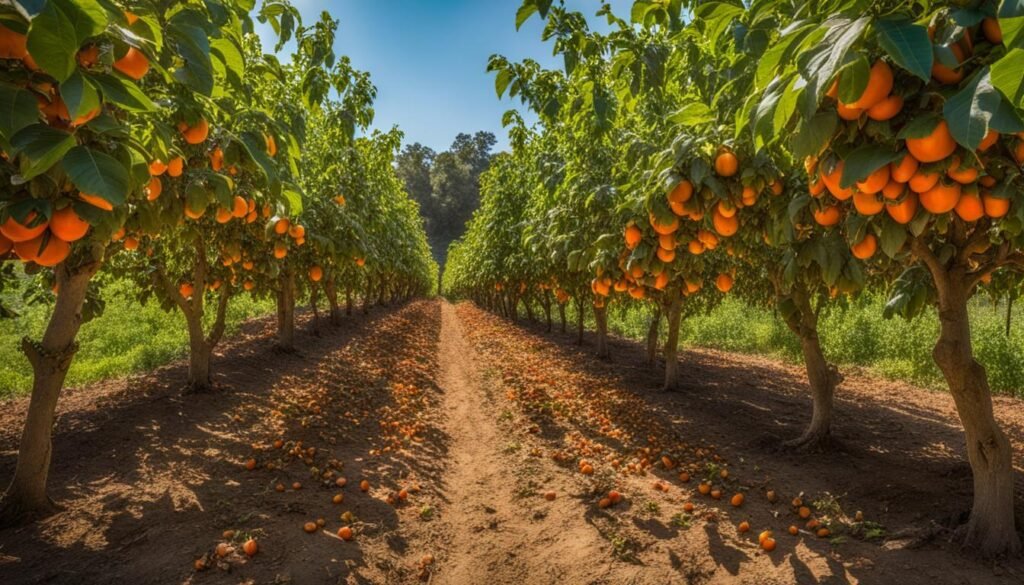
| Best Practices for Sustainable Persimmon Farming | Benefits |
|---|---|
| Promote biodiversity through companion planting | Enhances natural pest control and ecological balance |
| Avoid synthetic pesticides and fertilizers | Produces healthier and chemical-free persimmons |
| Implement water conservation techniques | Minimizes water waste and reduces environmental impact |
| Use organic mulch for weed control and moisture retention | Improves soil health and conserves water |
| Practice soil conservation methods | Preserves soil structure and fertility for long-term sustainability |
Exploring Innovative Techniques in Persimmon Farming
As persimmon farming continues to evolve, innovative techniques are emerging that offer unique opportunities for growers to optimize their orchard’s productivity and sustainability. These cutting-edge methods leverage advancements in technology and cultivation practices to maximize yield, improve fruit quality, and enhance overall efficiency in persimmon farming.
One such technique gaining traction is precision agriculture, which utilizes data-driven approaches to monitor and manage various aspects of persimmon cultivation. Through the use of sensors, drones, and satellite imagery, growers can collect real-time data on soil moisture levels, nutrient content, and plant health. This enables them to make informed decisions regarding irrigation, fertilization, and pest control, ensuring precise and targeted interventions. By employing precision agriculture techniques, farmers can optimize resource utilization, minimize waste, and achieve higher yields while reducing environmental impact.
Another innovative approach worth exploring is hydroponics, a soil-less cultivation method that is gaining popularity in persimmon farming. Hydroponic systems allow for precise control over growing conditions, such as nutrient levels, pH balance, and water availability. This results in faster growth, increased fruit production, and reduced susceptibility to pests and diseases. Additionally, hydroponic cultivation requires less water and space compared to traditional farming methods, making it an attractive option for growers with limited resources.
Vertical farming is another technique that holds promise for persimmon farmers. By utilizing vertical space and specialized lighting systems, growers can stack multiple layers of persimmon plants, increasing the overall yield per square foot of land. Vertical farming also offers greater control over environmental factors, such as temperature, humidity, and light exposure, allowing for year-round cultivation and reduced reliance on seasonal variations. This technique is particularly advantageous for urban areas or regions with limited arable land, where space is a constraint.
Table: Comparison of Innovative Techniques in Persimmon Farming
| Technique | Advantages | Challenges |
|---|---|---|
| Precision Agriculture | – Improved resource utilization – Enhanced pest and disease management – Higher yields |
– Initial investment in technology – Data interpretation and analysis |
| Hydroponics | – Faster growth and increased fruit production – Reduced water and space requirements – Greater control over growing conditions |
– Initial setup cost – Maintenance of nutrient solutions – Strict monitoring of pH and nutrient levels |
| Vertical Farming | – Higher yield per square foot of land – Year-round cultivation – Greater control over environmental factors |
– Initial investment in infrastructure – Energy consumption for lighting and climate control – Plant accessibility for maintenance |
Exploring these innovative techniques in persimmon farming presents exciting opportunities for growers to stay at the forefront of the industry and maximize their orchard’s potential. Each method offers its own set of advantages and challenges, and it’s essential for farmers to weigh their specific needs and resources before deciding which approach to adopt. By embracing innovation and staying informed about the latest advancements, persimmon farmers can position themselves for long-term success in this dynamic and evolving field.
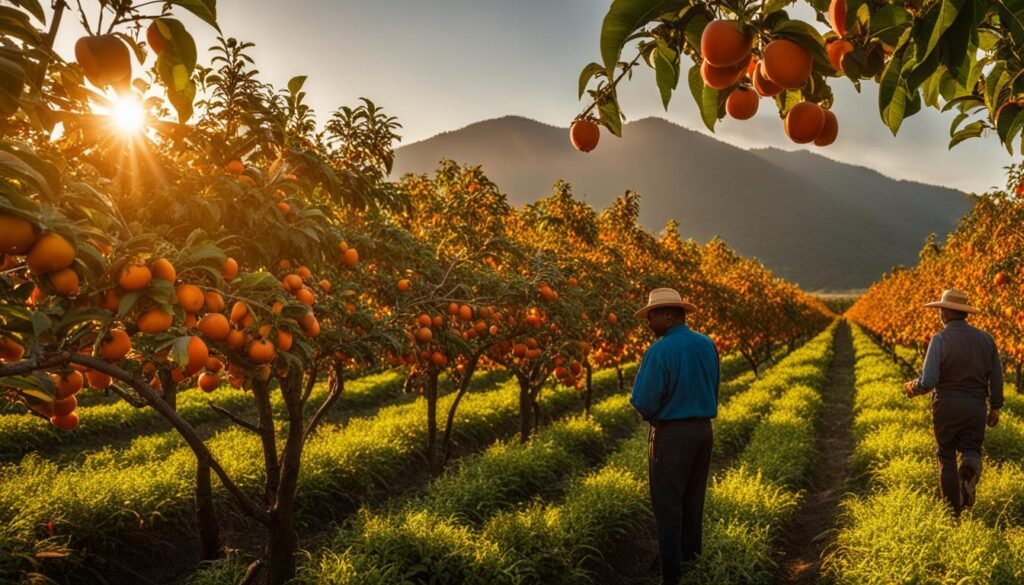
Conclusion
Persimmon farming is a fulfilling and profitable endeavor that can bring a vibrant addition to your orchard. By implementing effective persimmon farming techniques and embracing sustainable practices, you can unlock the full potential of your orchard and enjoy a bountiful harvest of delicious persimmons.
Remember to provide your persimmon trees with optimal growing conditions, including proper soil moisture levels, organic mulching, and adequate nutrient availability. Regular monitoring and integrated pest management strategies will help you manage the common pests and diseases that can affect persimmon trees.
Pruning and thinning practices are also essential for optimal fruit production, as they enhance fruit development and yield. Knowing when and how to harvest persimmons, as well as exploring various storage methods, will ensure that your fruits mature and retain their quality.
Lastly, embracing sustainable and organic practices not only benefits the environment but also meets the increasing demand for environmentally friendly produce. By staying informed about the latest advancements in persimmon farming and adapting your practices to the specific needs of your orchard, you can achieve long-term success in persimmon farming.
FAQ
What are the specific requirements for growing persimmon trees?
Persimmon trees thrive in full sun and well-drained soil, preferring slightly acidic to neutral pH levels. Regular watering and proper pruning and training techniques are also important for their growth and health.
How do I choose the right persimmon variety for my orchard?
It is crucial to select a persimmon variety that is suitable for your specific growing conditions and intended use. Consider factors such as growth habits, fruit quality, and market demand when making your decision.
What are the best practices for persimmon tree care?
Maintaining proper soil moisture levels, using organic mulch, ensuring adequate nutrient availability, and protecting the trees from extreme weather conditions, pests, and diseases are essential for persimmon tree care.
How do I manage pests and diseases in persimmon farming?
Implementing integrated pest management strategies, employing appropriate cultural and chemical controls, and regular monitoring can help prevent and manage pests and diseases in persimmon trees.
What is the importance of pruning and thinning in persimmon farming?
Pruning helps maintain tree shape, improve air circulation and sunlight penetration, and remove damaged branches. Thinning fruit clusters allows for larger, healthier fruits and prevents overcrowding that can lead to fungal infections.
When and how should I harvest persimmons?
Persimmons are typically harvested when they have reached their full color and are slightly soft to the touch. Careful handling and proper storage techniques are necessary to preserve their quality.
How can I effectively market and sell my persimmons?
Identifying target markets, building relationships with potential buyers, and implementing appropriate packaging and labeling techniques can increase the visibility and profitability of your persimmon products.
What are sustainable practices in persimmon farming?
Sustainable persimmon farming involves avoiding synthetic pesticides and fertilizers, promoting biodiversity, practicing water and soil conservation, and meeting the demand for environmentally friendly produce.
Are there innovative techniques in persimmon farming?
Yes, exploring innovative approaches such as precision agriculture, hydroponics, or vertical farming can provide unique opportunities for persimmon cultivation.
